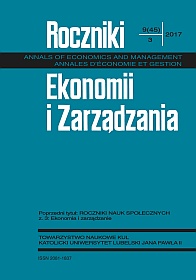Spatial Differentiation of Effectiveness of Sewerage Systems
Abstract
The main objective of the work is to identify conditions of spatial differentiation of effectiveness of sewerage systems. The effectiveness was defined as economic action, or more precisely efficiency of action. Its measure is the relation of outcomes expressed as the amount of sewage discharged into the sewage network and the amount of resources expended to the creation of this type of service, reflected as the length of the sewerage system. Efficiency of sewerage is defined as the amount of wastewater discharged into it per 1 km of the network. The results of the work provide confirmation of the formulated hypothesis that the efficiency of the sewerage networks, connected with the level of urbanization, decreased in all voivodeships. Together with its expansion on rural areas and suburbanisation areas, it was discharged getting smaller amount of wastewater from households per 1 km of sewerage system.
References
Frischmann B., An Economic Theory of Infrastructure and Commons Management, „Minnesota Law Review” 2005, nr 89, s. 917-1030.
Gans J., Williams P., Access Regulation and the Timing of Infrastructure, „Economic Record” 1999, nr 75, s. 127-137.
Gilowska Z., Finansowanie samorządu terytorialnego, „Samorząd Terytorialny” 2001, nr 1-2, s. 35-52.
Gilowska Z., Gminy gospodarujące, Krajowy Instytut Badań Samorządowych, Poznań 1994.
Gilowska Z., System ekonomiczny samorządu terytorialnego w Polsce, Municipium, Warszawa 1998.
Grzymała Z., Restrukturyzacja sektora komunalnego w Polsce. Aspekty organizacyjno- prawne i ekonomiczne, Oficyna Wydawnicza SGH, Warszawa 2010.
Helm D., Thompson D., Privatized transport infrastructure and incentives to invest, „Journal of Transport Economics and Policy” 1991, nr 25 (3), s. 231-246.
Hirschhausen C. von, Beckers T., Brenek A., Regulation and Long-Term Investment in Infrastructure Provision – Theory and Policy, „Utilities Policy” 2004, nr 12 (4), s. 203-210.
Jewtuchowicz A., Markowski T., Efekty zewnętrzne w systemach lokalnych, w: Rozwój gospodarki lokalnej w teorii i praktyce, red. B. Gruchman, J. Terajkowski, Akademia Ekonomiczna, Poznań 1990.
Kleer J., Samorząd lokalny – dobro publiczne, „Polityka Społeczna” 2009, nr 11, s. 8-12.
Kołodziejczyk D., Infrastruktura w rozwoju społeczno-gospodarczym gmin w Polsce, „Prace Naukowe Uniwersytetu Ekonomicznego we Wrocławiu” 2014, nr 360, s. 198-207.
Kupiec L., Rola infrastruktury w zagospodarowaniu przestrzennym, „Miasto” 1971, nr 9, s. 6-10.
Marlow D., Pearson L., MacDonald D., Whitten S., Burn, S., A Framework for Considering Externalities in Urban Water Asset Management, „Water Science and Technology”, 2011, nr 64 (11), s. 2199-2206.
Morales, M., Harris L., Öberg G., Citizenshit: The Right to Flush and the Urban Sanitation Imagery, „Environment and Planning” A 46 (2014), nr 12, s. 2816-2833.
Myna A., Modele rozwoju lokalnej infrastruktury technicznej, Wydawnictwo UMCS, Lublin 2012.
Myna A., Niepogoda R., Wnuk I., Infrastruktura komunalna w województwie lubelskim w latach 2011-2015, Urząd Statystyczny w Lublinie, Lublin 2016.
Öberg G., Merlinsky M., LaValle A., Morales M., Tobias M., The Notion of Sewage as Waste: A Study of Infrastructure Change and Institutional Inertia in Buenos Aires, Argentina and Vancouver, Canada, „Ecology and Society” 19 (2014), nr 2.
Pyszka A., Istota efektywności. Definicje i wymiary, „Zeszyty Naukowe Uniwersytetu Ekonomicznego w Katowicach” 2015, nr 230, s. 13-25.
Ratajczak M., Infrastruktura w gospodarce rynkowej, Akademia Ekonomiczna w Poznaniu, Poznań 1997.
Rudzka-Lorentz C., Sierak J., Zarządzanie finansami w gminach, W: Zarządzanie gospodarką i finansami gminy, red. H. Sochacka-Krysiak, Oficyna Wydawnicza SGH, Warszawa 2006, s. 183-238.
Sadowy M., Grzymała Z., Problemy zarządzania gospodarką komunalną, w: Nowe zarządzanie publiczne w polskim samorządzie terytorialnym, red. A. Zalewski, Oficyna Wydawnicza SGH, Warszawa 2007.
Savas E.S., Prywatyzacja. Klucz do lepszego rządzenia, Wydawnictwo Naukowe PWN, Warszawa 1992.
Ustawa z dnia 10 maja 1990 r. Przepisy wprowadzające ustawę o samorządzie terytorialnym i pracownikach samorządowych (Dz.U. nr 32, poz. 191, z późn. zm.).
Ustawa z dnia 8 marca 1990 r. o samorządzie gminnym (Dz.U. nr 16, poz. 95 z późn. zm.).
Wojciechowski E., Zarządzanie w samorządzie terytorialnym, Difin, Warszawa 2003.
Zalewski A., Efekty nowego zarządzania publicznego, „Prace Naukowe Akademii Ekonomicznej we Wrocławiu” 2004, nr 1023, s. 581-590.
Zysnarski J., Geneza i modele partnerstwa publiczno-prywatnego, w: Program prywatyzacji podmiotów komunalnych, Doradca Consultants, Gdańsk 2004.
Copyright (c) 2017 Roczniki Ekonomii i Zarządzania

This work is licensed under a Creative Commons Attribution-NonCommercial-NoDerivatives 4.0 International License.


